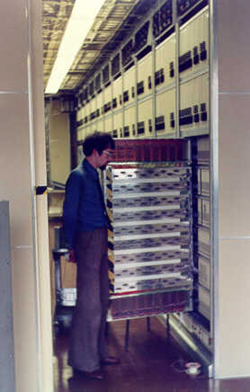 |
One of the first model electronic exchanges opened in Dollis Hill in 1959, followed by an 800 line unit at Highgate Wood, London in 1962. Both used TDM (Time Division Multiplexing) and PAM (Pulse Amplitude Modulation) systems. However, as integrated circuits and microprocessors had not yet been developed, the costs were too high and therefore SD (Space Division) techniques using reed relays were chosen. Thus the first SD exchanges of 200 lines were tested at Leamington Spa and Peterborough in 1965, followed by the first production TXE2 in Ambergate in 1966. |
TXE1 a larger experimental reed electronic exchange installed in 1968 in Leighton Buzzard, Bedfordshire for up to 3000 lines. It was later extended by using a TXE6 as a pre-1st selector stage which then routed to the TXE1 or either of two TXE2s. Although this wasn't ideal, it was more desirable than having to revert to a Strowger expedient!
TXE2
TXE2 the first production electronic exchange opened in Ambergate, Derbyshire on 15 December 1966. Used extensively for 400-4000 line Non-Director exchanges. There were at least 3 versions of the TXE2 as the design was improved to handle more subscribers and traffic:-
|
TXE2R a reduced height version.
TXE3 larger updated version of TXE1, but was only used in field trials and was superseded by.....
TXE4
TXE4 an improved cost-reduced version of TXE3. Following public trials in 1969 it went into production with STC in 1971.
TXE4RD- Rectory Design the first production exchange opened in Birmingham in February 1976.
TXE4A- enhanced, cost reduced version using large scale integration to replace the threaded-wire stores of the TXE4RD. The first TXE4A went into public service in Belgrave, Leicester on 28th February 1981.
Other Variants
TXE5 a trial version of a cost reduced TXE2.
TXE6 the Reed Selector, used the step-by-step principles and was designed for extension and replacement of Strowger units, but was only ever used to extend the TXE1, as above.
UXE7 by GEC- only 12 or so of these Unit eXchanges, Electronic No.7 were deployed in remote hamlets. The unit in Diabaig on the North West coast of Scotland, replaced an existing UAX12 on 2nd April 1981.
UXE8 by Plessey - as above, only 12 of these Unit eXchanges, Electronic No.8 were produced and used mainly in the South West of Scotland. The first UXE8 was brought into public service at 08:00 hrs on 22nd May 1980 when 315 lines were transferred from Wigtown UAX14.
All logos and trade marks are the property of their respective owners and are used on the Light Straw site(s) for review only. Students and researchers are recommended to make their own independent enquiries as to the accuracy of the information contained therein.
